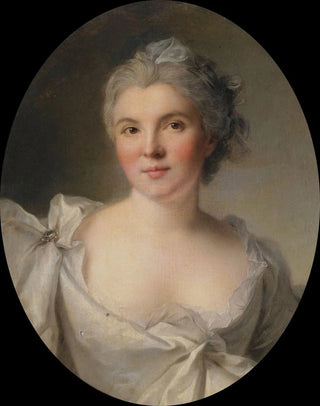Art print | Portrait of a woman - Jean-Marc Nattier


View from behind

Frame (optional)
Portrait of a woman - Jean-Marc Nattier – Captivating introduction
The "Portrait of a woman" by Jean-Marc Nattier is an iconic work from the 18th century, embodying the elegance and refinement of French painting of the era. This painting, both intimate and majestic, offers a fascinating glimpse into the artistic sensitivity of its creator. The depiction of a woman with a delicate face and sumptuous clothing irresistibly draws the eye, inviting the viewer to immerse themselves in a universe where beauty and grace reign supreme. Through this art print, one can feel not only Nattier's technical virtuosity but also an atmosphere imbued with softness and mystery, characteristic of his style.
Style and uniqueness of the work
Nattier's style is distinguished by a delicate and refined approach, where every detail is carefully considered. In the "Portrait of a woman," light plays a crucial role, illuminating the protagonist's face in an almost divine manner. The colors, chosen with care, create a visual harmony that delights the eye. The drapery, with its great fluidity, seems almost alive, while accessories such as jewelry and floral ornaments add a touch of sophistication. Nattier excels in capturing emotions and nuances of the human soul, managing to convey an impression of serenity and depth. This work, through its balanced composition and refined aesthetic, stands as a timeless testament to the taste and aspirations of its time.
The artist and his influence
Jean-Marc Nattier, born in 1685, is often recognized as one of the most influential portraitists of his era. Trained in the Parisian artistic milieu, he managed to establish himself thanks to his exceptional talent and his ability to capture the essence of his models. Nattier had the honor of painting numerous figures from the court, including members of the nobility and royalty, which allowed him to develop a style that combines intimacy and grandeur. His influence is felt not only in the field of portraiture but also in the way subsequent artists approached the representation of women. His ability to enhance beauty and to

Matte finish

View from behind

Frame (optional)
Portrait of a woman - Jean-Marc Nattier – Captivating introduction
The "Portrait of a woman" by Jean-Marc Nattier is an iconic work from the 18th century, embodying the elegance and refinement of French painting of the era. This painting, both intimate and majestic, offers a fascinating glimpse into the artistic sensitivity of its creator. The depiction of a woman with a delicate face and sumptuous clothing irresistibly draws the eye, inviting the viewer to immerse themselves in a universe where beauty and grace reign supreme. Through this art print, one can feel not only Nattier's technical virtuosity but also an atmosphere imbued with softness and mystery, characteristic of his style.
Style and uniqueness of the work
Nattier's style is distinguished by a delicate and refined approach, where every detail is carefully considered. In the "Portrait of a woman," light plays a crucial role, illuminating the protagonist's face in an almost divine manner. The colors, chosen with care, create a visual harmony that delights the eye. The drapery, with its great fluidity, seems almost alive, while accessories such as jewelry and floral ornaments add a touch of sophistication. Nattier excels in capturing emotions and nuances of the human soul, managing to convey an impression of serenity and depth. This work, through its balanced composition and refined aesthetic, stands as a timeless testament to the taste and aspirations of its time.
The artist and his influence
Jean-Marc Nattier, born in 1685, is often recognized as one of the most influential portraitists of his era. Trained in the Parisian artistic milieu, he managed to establish himself thanks to his exceptional talent and his ability to capture the essence of his models. Nattier had the honor of painting numerous figures from the court, including members of the nobility and royalty, which allowed him to develop a style that combines intimacy and grandeur. His influence is felt not only in the field of portraiture but also in the way subsequent artists approached the representation of women. His ability to enhance beauty and to






